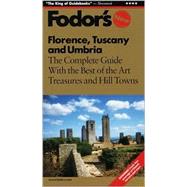
| On the Road with Fodor's About Our Writers: Each year the Gold Guides are written and updated by more than 500 resident writers | |
| New This Year: Keeps you up to the minute on recent changes | |
| Connections How to Use This Book: Describes organization, icons, and other key information | |
| Don't Forget to Write: Tells you how to get in touch with our editors | |
| The Gold Guide Smart Travel Tips A to Z: An easy-to-use section divided alphabetically by topic | |
| Under each listing you'll find tips and information that will help you accomplish what you need to in Florence, Tuscany, and Umbria | |
| You'll also find addresses and telephone numbers of organizations and companies that offer destination-related services and detailed information and publications | |
| Destination: Florence, Tuscany, and Umbria: Helps get you in the mood for your trip | |
| Introduction New and Noteworthy: Cues you in on trends and happenings | |
| What's Where: Gets you oriented | |
| Pleasures and Pastimes: Describes the activities and sights that make Florence Tuscany and Umbria unique | |
| Fodor's Choice: Showcases our top picks from special restaurants and one-of-a-kind accommodations to out-of-the-ordinary sights and activities.. | |
| Let them inspire you! Festivals, Seasonal Events: Alerts you to special events you'll want to seek out | |
| Florence North of Florence Cities West of Florence Chianti Siena and the Hill Towns Arezzo, Cortona, and Southern | |
| Tuscany Perugia and Northern Umbria Assisi, Spoleto, and Southern Umbria Portraits of Florence, Tuscany, and Umbria Florence, Tuscany, and Umbria at a Glance | |
| A Chronology Artistically Speaking: A Glossary Books and Videos | |
| Index | |
| Table of Contents provided by Publisher. All Rights Reserved. |
The New copy of this book will include any supplemental materials advertised. Please check the title of the book to determine if it should include any access cards, study guides, lab manuals, CDs, etc.
The Used, Rental and eBook copies of this book are not guaranteed to include any supplemental materials. Typically, only the book itself is included. This is true even if the title states it includes any access cards, study guides, lab manuals, CDs, etc.
Excerpted from Florence, Tuscany and Umbria: The Complete Guide with the Best of the Art Treasures and Hill Towns by Fodor's Travel Publications, Inc. Staff
All rights reserved by the original copyright owners. Excerpts are provided for display purposes only and may not be reproduced, reprinted or distributed without the written permission of the publisher.